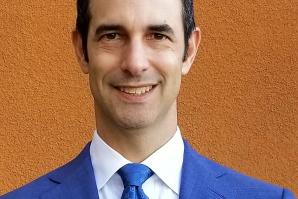After five years as the Secretary of the California State Transportation Agency, Brian Kelly took the helm as CEO of California High Speed Rail Authority, effective February 1. We sat down with him to talk about the state’s critical infrastructure needs and the nation’s first high-speed rail system as construction continues in the Central Valley.
What prompted you to leave CalSTA to take the position of CEO at California High Speed Rail Authority?
I believe high-speed rail is the right thing to do for California. It is a rare project that can drastically cut travel times and provide a mobility option that is clean, fast and efficient. I believe in building things that speak to tomorrow’s challenges and will serve future generations well. High-speed rail fits that bill. I want to commit myself to delivering this project for Californians.
Related: The Conductor
Related: Status Check: High-Speed Rail
Related: In the Driver’s Seat
The news about high-speed rail costs going up by another $2.8 billion has created even greater scrutiny and concern over its long-term viability. What is your action plan to get high-speed rail past short-term challenges and ultimately to long-term success?
In the short-term, the plan is to bolster the authority’s capability and deliver a plan to the legislature and public that fully articulates the challenges and the strategies to overcome those challenges, and deliver the project. Over the long-term, it will be to run an organization that is constantly gaining credibility by delivering the project segment by segment. As we do this and show the public real trains operating at the earliest possible time, the public will see the mobility, environmental and economic benefits, and they will demand more.
We’re very focused on high-speed rail, but local mass transit is always going to have a greater impact on more people. What more can and should we be doing to grow local mass transit?
It’s important to note that public transit in California is almost entirely run locally. There are on the order of 227 different public transit operators in this state, and too often it gets into wars over turf rather than how we are helping people move across different providers. So we are putting out cap-and-trade and now SB 1 dollars for what we are calling transformative transit projects that would help connect folks. And we’re also using some of those dollars to support things like easier ticketing, one pass for many transit operators and improving the connection times between services. This is where high-speed rail is the most important element of how the state can help. High-speed rail is proposed to be a fast train between San Francisco and Los Angeles, but it will not be successful if it is not connecting well with regional and local public transit providers. So we want to make sure transfers are easy, single ticketing is a probability, and we are improving the connection times between these services.
Californians know their local streets and roads, and in some instances bridges and highways they travel on, are not in the condition they should be.
California is just one of several states which have raised gas taxes to pay for roads and bridges. There is, however, a ballot measure afoot to repeal this tax. What happens if voters endorse that measure?
What happens is we simply won’t invest in the transportation system. Californians know their local streets and roads, and in some instances the bridges and highways they travel on are not in the condition they should be in. And that’s a byproduct of not touching the gas tax in 23 years. And so if we don’t periodically revisit it and adjust it so we can accommodate that growth, the system just degrades. We have, for the last several years, been ranked somewhere around the bottom for the conditions of our infrastructure. We can and we should do better. But part of that is because it has been difficult to invest with limited revenue. We travel more miles by car in California than Florida, New York and Texas combined, and the opponents to SB 1 are not offering any viable alternative. They’re just not.
The ‘Fix It First’ mantra of addressing critical repairs to roads, bridges and highways is an obvious logical starting point to address our infrastructure needs. But how do those fixes fit into long-term plans to ease traffic congestion?
Listen now: Creating a Culture of Community Around Transportation
Related: Not Driving to Work is the Hot New High-End Job Perk
While it’s true that something around 65 percent of the money SB 1 generates is for Fix It First, there is a lot of money that will go toward expanding capacity projects. We have $300 million per year — over $3 billion in 10 years — that will go toward improving our trade corridors in California. Three of the five largest ports in the nation are in California. So we have targeted investments into trade corridors. We have a new program in this bill — about $2.5 billion over the next decade — to invest in congested corridors mostly in our urban areas. The first round of those dollars is going to be awarded for expanded capacity projects in early spring of 2018. So expanding capacity is a big part of this bill. I spent 17 years in the Senate and knew we were not going to get a bill through that was just Fix It First. You have to be able to address the dynamic needs of this state’s entire transportation system.
Some lawmakers and the state Legislative Analyst’s Office have claimed Caltrans is overstaffed by thousands of employees, costing the state $500 million annually that should be spent on roads and other infrastructure. What’s your response to those claims?
My first response is that I took that charge seriously. I wrote a letter to the California Transportation Commission, the oversight body for transportation revenues, and asked them to get the Department of Finance, the LAO staff and legislative staff from both parties together to review staffing issues at Caltrans. [That team] spent almost a year looking at the issue and determined Caltrans staffing estimates are reasonable right now, but to ensure they stay that way [it] recommended staffing needs be forwarded to the California Transportation Commission, which allocates funding. We agreed to that, and that requirement is in SB 1. I know heavy critics of the bureaucracy don’t want to acknowledge this, but the fact of the matter is under Governor Jerry Brown, Caltrans staff has been reduced every year. Caltrans is at a 19-year low in the number of approved positions for the work they do, and they are still delivering roughly the same amount of projects. I call that efficiency.
Caltrans has experienced great success by heavily incentivizing contractors to finish major road projects ahead of schedule. Do you anticipate going back to that policy, especially with a ramp-up of projects, using that heavy incentivization to get these projects done faster?
There are two things that I see. One, is that I encouraged departments to use incentives in their contracts and they’ve had success, particularly around the Sacramento region where incentive-based projects helped get some things done more quickly. Fix 50 was a prime example of that. I think we will see more of that in the future. We also have sought from the legislature more tools in how we deliver projects. Under the traditional low-bid design, we design a project and then put it out to bid. That’s a good thing. The bad news is, sometimes the contractor who builds it and the designer who designed it are not on the same page. So tools like using design-build or something called a constructive management general contractor are other ways of bidding the contracts where the contractor is involved earlier in the design phase. You get more continuity earlier in the project and you can usually get the project done sooner. We used a CMGC most recently on demolishing the old Bay Bridge, where we are a year ahead of schedule and saving around $10 million on the project. So we’re going to use all sorts of things.
California finally has rules to allow the testing of autonomous vehicles on our roadways. What are some of the biggest opportunities for us with driverless cars?
One thing is that autonomous cars are a way to make the driving experience much safer. That’s a public safety benefit we can’t ignore. There are also many Californians who, for whatever reason, are not physically able to drive, so this would give access to mobility for many people who can’t otherwise drive. Those are the two great opportunities: access to mobility and safety. There are now 43 manufacturers with around 240 autonomous cars on the road today and we haven’t had one fatality. That is a good standard, but now we’re getting to the hard part. How do you test with nobody behind the wheel? That concept is scary for a lot of people, but I think our job is to try and lay out a pathway for the manufacturers to safely test this on public roads and ultimately show them how they can get to deployment. I know many have said California is going slow, but I don’t think there is any state that has as many manufacturers testing on our public roads as we do today.
What of our state’s transportation infrastructure needs are most critical?TWEET US @COMSTOCKSMAG.
Recommended For You

Electric Avenue
How will Sacramento’s designation as a ‘Green City’ shift the transportation landscape?
Last summer, Sacramento learned it would become Volkswagen’s first “Green City,” earning millions in investment from the tarnished brand’s subsidiary, Electrify America. Where will this money go, and what does it mean for the local auto technology industry?

Back and Forward: Lloyd Levine
Director of media and public relations of Sacramento Electric Vehicle Association on EV adoption
Lloyd Levine, a former state legislator, and the current director of media and public relations for the Sacramento Electric Vehicle Association offers us his insight into electric vehicle adoption.




Comments
I suggest we get rid of Cal-Trans all together or cut it considerably down. Spend the money targeted for infrastructure ONLY for that purpose .Lets get rid of bureaucracy and work for the public who actually pays the bills.